
Worminghall is a village and civil parish in the Buckinghamshire district of the ceremonial county of Buckinghamshire, England.

Sherborne Castle is a 16th-century Tudor mansion southeast of Sherborne in Dorset, England, within the parish of Castleton. Originally built by Sir Walter Raleigh as Sherborne Lodge, and extended in the 1620s, it stands in a 1,200-acre (490 ha) park which formed a small part of the 15,000-acre (61 km2) Digby estate. Within the grounds lie the ruins of the 12th-century Sherborne Old Castle, now in the care of English Heritage.

Hall for Cornwall, known as Truro City Hall until 1997, is an events venue in Boscawen Street in Truro, Cornwall, England. The building, which was previously the headquarters of Truro City Council, is a Grade II* listed building.

King Street is a 17th-century street in the historic city centre of Bristol, England.

Camden Town Hall, known as St Pancras Town Hall until 1965, is the headquarters of Camden London Borough Council. The main entrance is in Judd street with its northern elevation extending along Euston Road, opposite the main front of St Pancras railway station. It has been Grade II listed since 1996.

The Ifield Friends Meeting House is a Friends meeting house in the Ifield neighbourhood of Crawley, a town and borough in West Sussex, England. Built in 1676 and used continuously since then by the Quaker community for worship, it is one of the oldest purpose-built Friends meeting houses in the world. It is classified by English Heritage as a Grade I listed building, a status given to buildings of "exceptional interest" and national importance. An adjoining 15th-century cottage is listed separately at Grade II*, and a mounting block in front of the buildings also has a separate listing at Grade II. Together, these structures represent three of the 100 listed buildings and structures in Crawley.
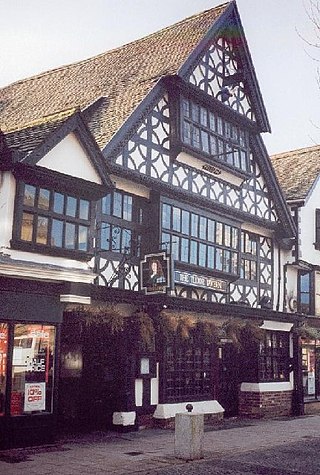
The Tudor Tavern at No 15 Fore Street, Taunton, Somerset, England has been designated as a Grade I listed building. Built in 1578, the house is three storeys high of a timber-frame construction, with jettied first and second floors. The frontage is of carved bressummers with interlocking curved braces, while the roof is red tiles. There is a medieval hall with an open trussed roof behind the front.
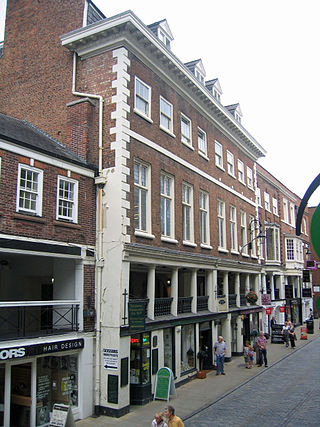
Booth Mansion is a former town house at 28–34 Watergate Street, Chester, Cheshire, England. It contains a portion of the Chester Rows, is recorded in the National Heritage List for England as a designated Grade I listed building, and is included in the English Heritage Archive. Its frontage was built in 1700 in Georgian style but much medieval material remains behind it.

The Ossulston Estate is a multi-storey council estate built by the London County Council on Chalton Street in Somers Town between 1927 and 1931. It was unusual at the time both in its inner-city location and in its modernist design, and all the original parts of the estate are now Grade II listed buildings.

The Westgate area of Gloucester is centred on Westgate Street, one of the four main streets of Gloucester and one of the oldest parts of the city. The population of the Westgate ward in Gloucester was 6,687 at the time of the 2011 Census.

The Whittington Stone is an 1821 monumental stone and statue of a cat at the foot of Highgate Hill, a street, in Archway. It marks roughly where it is recounted that a forlorn character of Dick Whittington, loosely based on Richard Whittington, returning to his home from the city of London after losing faith as a scullion in a scullery, heard Bow Bells ringing from 4+1⁄2 miles (7.2 km) away, prophesying his good fortune leading to the homage "Turn again Whittington, thrice Lord Mayor of London!" This quotation and a short history of the man cover two faces of the stone. The pub next to it is of the same name.
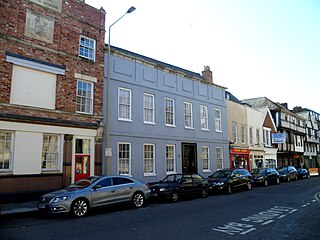
Hyatt House, or Hyett House, is a grade II listed building at 91 Westgate Street in the English city of Gloucester. The building is of a timber frame with stone and was probably constructed in the 16th century. According to a plaque on the building, an earlier dwelling stood on the site at least as early as 1455. The current façade was probably constructed by Nicholas Hyett (1709–1777), a local lawyer and justice of the peace. In 1988 the building was converted to flats by Avondown Housing Association and Gloucester City Council.
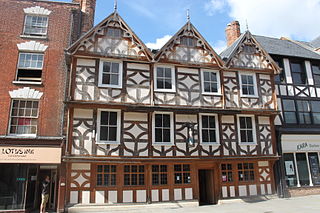
Robert Raikes' House is an historic 16th century timber-framed town house at 36–38 Southgate Street, Gloucester. It is now used as a public house called the Robert Raikes Inn.
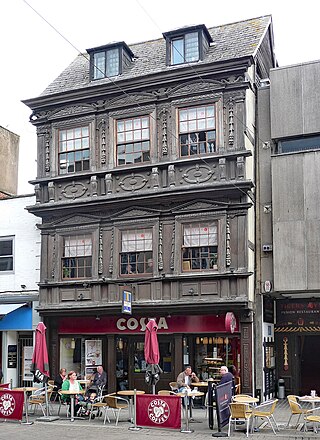
9 and 9A Southgate Street is a 17th-century Jacobean timber-framed merchant's house on Southgate Street, Gloucester. It has been a Grade I listed building since 23 January 1952. 9 Southgate Street is now occupied by Costa Coffee and 9A Southgate Street is occupied by The Tiger's Eye restaurant.
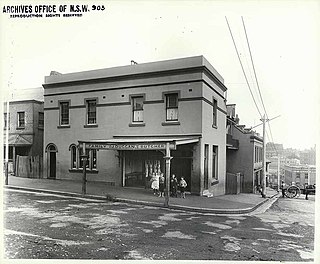
The Butchery Building is a heritage-listed restaurant and former terraced houses and butcher's shop located at 178–180 Cumberland Street, in the inner city Sydney suburb of The Rocks in the City of Sydney local government area of New South Wales, Australia. It was built from 1890 to 1899. It is also known as The Butchery Buildings. The property is owned by Property NSW, an agency of the Government of New South Wales. It was added to the New South Wales State Heritage Register on 10 May 2002.

46–56 Gloucester Street, The Rocks is a heritage-listed residence located at 46–56 Gloucester Street, in the inner city Sydney suburb of The Rocks in the City of Sydney local government area of New South Wales, Australia. It was built during 1914. It is also known as Edwardian Cottages. The property is partially privately owned, with the residue owned by Property NSW, an agency of the Government of New South Wales. It was added to the New South Wales State Heritage Register on 10 May 2002.

The Little Thatch is a 14th-century timber-framed building at 141 Bristol Road, Quedgeley, Gloucester. It is now used as a public house and hotel.
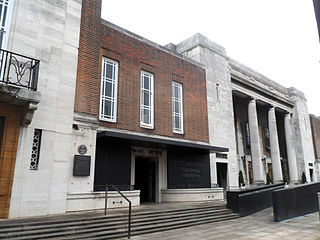
Stoke Newington Town Hall is a municipal building in Church Street, Stoke Newington, London. It is a Grade II listed building.

Scarborough Town Hall, originally St Nicholas House, is a red brick Jacobean Revival mansion in Scarborough, North Yorkshire, England, currently used as a municipal building for the Borough of Scarborough and an events venue. It was built in the 19th century as a home for John Woodall, a prominent local businessman, and then converted and extended for municipal use in 1903. Situated overlooking the South Bay, it is a grade II listed building.



















